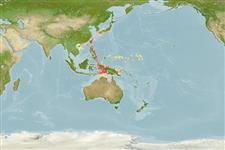Klassifizierung / Names
Namen | Synonyme | Catalog of Fishes(Gattung, Arten) | ITIS | CoL | WoRMS | Cloffa
>
Gobiiformes (Gobies) >
Gobiidae (Gobies) > Gobiinae
Etymology: Trimma: Greek, trimma, -atos = something crushed (Ref. 45335); fasciatum: Name from Latin 'fasciatum' meaning bands, referring to the yellow bands of body of this species..
Environment: milieu / climate zone / depth range / distribution range
Ökologie
seewasser; tiefenbereich 25 - 30 m (Ref. 91085). Subtropical
Western Pacific: Japan and Palau.
Size / Gewicht / Alter
Maturity: Lm ? range ? - ? cm
Max length : 2.0 cm SL Männchen/unbestimmt; (Ref. 91085)
Kurzbeschreibung
Morphologie | Morphometrie
Rückenflossenstacheln (insgesamt): 7; Rückenflossenweichstrahlen (insgesamt): 8; Afterflossenstacheln 1; Afterflossenweichstrahlen: 8; Wirbelzahl: 26. This species is distinguished from its congeners by the following set of characters: predorsal scales 8; first dorsal fin without elongate and filamentous spine; unbranched pectoral-fin rays; height of basal membrane between innermost pelvic-fin rays about 23% of length of fifth ray; shallow to moderate interorbital groove; narrow interorbital space and bony width 18-26% of pupil diameter; when fresh and when alive, nape with 1 or 2, and body with 4 broad bright yellow bands (Ref. 91085).
Life cycle and mating behavior
Geschlechtsreife | Fortpflanzung | Ablaichen | Eier | Fecundity | Larven
Suzuki, T., J. Sakaue and H. Senou, 2012. Two new species of the gobiid fish genus Trimma (Actinopterygii: Perciformes: Gobiidae) from Japan and Palau. Bull. Nat. Mus. Nat. Sci. Suppl. 6:67-77. (Ref. 91085)
IUCN Rote Liste Status (Ref. 130435)
Bedrohung für Menschen
Harmless
Nutzung durch Menschen
Mehr Information
NamenSynonymeMetabolismusRäuberÖkotoxikologieFortpflanzungGeschlechtsreifeAblaichenSpawning aggregationFecundityEierEientwicklung
Alter/GrößeWachstumLänge-GewichtLänge-LängeLängenhäufigkeitenMorphometrieMorphologieLarvenLarven Pop.Dyn.RekrutierungDichteBRUVS
ReferenzenAquakulturAquakultur ProfilZuchtlinienGenetikElectrophoresesVererbbarkeitKrankheitenVerarbeitungNutrientsMass conversion
PartnerBilderStamps, Coins Misc.LauteCiguateraGeschwindigkeitSchwimmstilKiemenoberflächeOtolithsGehirngrößeSehfähigkeit
Tools
Zusatzinformationen
Download XML
Internet Quellen
Estimates based on models
Preferred temperature (Ref.
123201): 23.2 - 27.8, mean 27.4 °C (based on 14 cells).
Phylogenetic diversity index (Ref.
82804): PD
50 = 0.5000 [Uniqueness, from 0.5 = low to 2.0 = high].
Bayesian length-weight: a=0.00708 (0.00333 - 0.01504), b=3.09 (2.92 - 3.26), in cm total length, based on LWR estimates for this (Sub)family-body shape (Ref.
93245).
Widerstandsfähigkeit (Ref.
120179): hoch, Verdopplung der Population dauert weniger als 15 Monate. (Preliminary K or Fecundity.).
Fishing Vulnerability (Ref.
59153): Low vulnerability (10 of 100).
